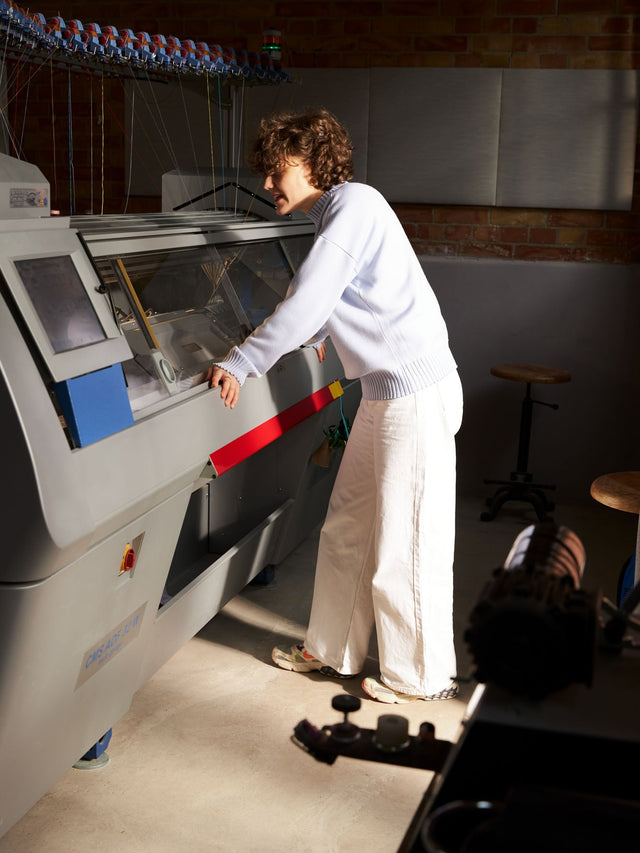Explained: Custom Knitwear Development
Felix: What are the advantages of industrial knitting compared to traditional knitting methods such as hand knitting or hand knitting machines?
Luisa: Industrial knitting machines are revolutionising knitting technology by making it possible to create complex patterns and fine textures with high precision. In contrast to hand knitting or the use of mechanical hand knitting machines, the programmability and automation of industrial knitting machines enable unrivalled efficiency and variety in production. I can work with a wide range of yarns and realise details that would be almost impossible to achieve manually.
Felix: For which areas in industry and design is industrial knitting relevant?
Luisa: Industrial flat-knitting plays a major role in many areas, often in applications that one would not expect at first glance. Its use in the clothing sector is obvious, but many people are surprised to learn that sneakers are mostly knitted today. However, knitting is also widely used in technical textiles, for example in medical technology in the manufacture of bandages or support stockings and in the automotive industry for seat or interior covers. The textile head holder for the new Apple Vision glasses is also a product of industrial knitting. A significant advantage of knitting is the ability to produce textiles directly and seamlessly in their final, three-dimensional form. In addition, special knitting techniques make it possible to give textiles unique properties such as breathability or electrical conductivity. Knitting is also used in product design and interior design, for example for furniture covers or cushion covers.
Felix: How does the process work when customers come to you with a project?
Luisa: My approach is customer-oriented and creative. I start by discussing the client’s idea and inspiration, often supported by visual materials such as sketches or mood boards. My aim is to gain a clear impression of the client’s wishes and ideas. I then select the right knitting options, yarns and colours together with them. I provide advice, make suggestions and evaluate feasibility. I guide customers through the entire development process, even if they have no specific prior knowledge in the field of knitting.
Felix: What steps follow after the initial collection of ideas?
Luisa: Once I have developed a common understanding of the project, I start with the practical realisation. This includes selecting the yarn and creating knitting samples to visualise the feel and look of the end product. At the same time, I also work on adapting or creating patterns that are optimised for knitting as required. This iterative process allows me to make fine adjustments and ensure that the end product exactly matches the customer’s expectations.
Felix: How do you proceed once the design is finalized?
Luisa: Once the design and materials have been selected, I start making a prototype. This step is crucial to assess the fit and overall look. Customers have the opportunity to inspect the product and request any necessary changes. Based on the feedback, I optimise the product before going into final production. For individual pieces or smaller quantities, I can realise the production directly in my studio. For larger orders, I work with specialised partners in Germany or Europe and supervise the production there for my customers.
Felix: What advice would you give to anyone interested in starting a knitting project?
Luisa: The most important thing is to have a vision or idea of the desired product. Visualisations, whether through sketches or mood boards, are very helpful. Customers don’t have to be experts in knitting. I specialise in translating ideas into feasible projects. I encourage anyone interested in the unique opportunity of industrial knitting to get in touch with me to turn their visions into reality.

